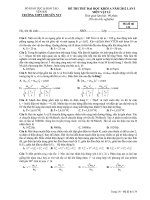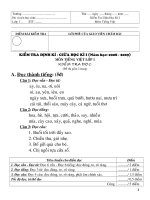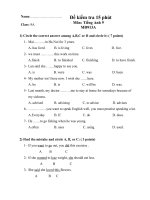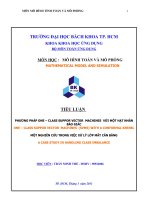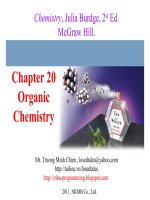Organic chemistry with a biological emphasis volume i
Bạn đang xem bản rút gọn của tài liệu. Xem và tải ngay bản đầy đủ của tài liệu tại đây (8.72 MB, 467 trang )
University of Minnesota Morris Digital Well
University of Minnesota Morris Digital Well
Chemistry Faculty
Chemistry
1-2016
Organic Chemistry with a Biological Emphasis
Volume I
Timothy Soderberg
Follow this and additional works at: />Part of the Biochemistry Commons, and the Organic Chemistry Commons
Recommended Citation
Soderberg, Timothy, "Organic Chemistry with a Biological Emphasis Volume I" (2016). Chemistry Faculty. 1.
/>
This Book is brought to you for free and open access by the Chemistry at University of Minnesota Morris Digital Well. It has been accepted for
inclusion in Chemistry Faculty by an authorized administrator of University of Minnesota Morris Digital Well. For more information, please contact
Organic Chemistry
With a Biological Emphasis
Volume I: Chapters 1-8
Tim Soderberg
University of Minnesota, Morris
January 2016
Organic Chemistry With a Biological Emphasis
Tim Soderberg
This work is licensed under the Creative Commons Attribution-NonCommercial-ShareAlike 4.0
International License. />
Organic Chemistry With a Biological Emphasis (2016 ed.)
Tim Soderberg
Notes to the reader:
This textbook is intended for a sophomore-level, two-semester course in Organic
Chemistry targeted at Biology, Biochemistry, and Health Science majors. It is assumed
that readers have taken a year of General Chemistry and college level Introductory
Biology, and are concurrently enrolled in the typical Biology curriculum for sophomore
Biology/Health Sciences majors.
The book is meant to be a constantly evolving work in progress, and as such, feedback
from students, instructors, and all other readers is greatly appreciated. Please send any
comments, suggestions, or notification of errors to the author at
If you are looking at a black and white printed version of this textbook, please be aware
that most of the figures throughout are meant to contain color, which is used to help the
reader to understand the concepts being illustrated. It will often be very helpful to refer to
the full-color figures and internet links in a digital PDF version of the book, which is
available for free download at:
/>The digital book is continuously being updated, so please check back to this site
periodically to download the most recent version.
Organic Chemistry With a Biological Emphasis (2016 ed.)
Tim Soderberg
Organic Chemistry With a Biological Emphasis (2016 ed.)
Tim Soderberg
Table of Contents
Volume I: Chapters 1-8
Chapter 1: Introduction to organic structure and bonding, part I
Introduction: Pain, pleasure, and organic chemistry: the sensory effects of capsaicin and
vanillin
Section 1: Drawing organic structures
A: Formal charge
B: Common bonding patterns in organic structures
C: Using the 'line structure' convention
D: Constitutional isomers
Section 2: Functional groups and organic nomenclature
A: Functional groups in organic compounds
B: Naming organic compounds
C: Abbreviating organic structure drawings
Section 3: Structures of some important classes of biological molecules
A: Lipids
B: Biopolymer basics
C: Carbohydrates
D: Amino acids and proteins
E: Nucleic acids (DNA and RNA)
Chapter 2: Introduction to organic structure and bonding, part II
Introduction: Moby Dick, train engines, and skin cream
Section 1: Covalent bonding in organic molecules
A: The bond in the H2 molecule
B: sp3 hybrid orbitals and tetrahedral bonding
C: sp2 and sp hybrid orbitals and bonds
Section 2: Molecular orbital theory
A: Another look at the H2 molecule using molecular orbital theory
B: MO theory and conjugated bonds
C: Aromaticity
Section 3: Resonance
A: What is resonance?
B: Resonance contributors for the carboxylate group
C: Rules for drawing resonance structures
D: Major vs minor resonance contributors
Organic Chemistry With a Biological Emphasis
Tim Soderberg
Table of Contents
Section 4: Non-covalent interactions
A: Dipoles
B: Ion-ion, dipole-dipole and ion-dipole interactions
C: Van der Waals forces
D: Hydrogen bonds
E: Noncovalent interactions and protein structure
Section 5: Physical properties of organic compounds
A: Solubility
B: Boiling point and melting point
C: Physical properties of lipids and proteins
Chapter 3: Conformation and Stereochemistry
Introduction: Louis Pasteur and the discovery of molecular chirality
Section 1: Conformations of open-chain organic molecules
Section 2: Conformations of cyclic organic molecules
Section 3: Chirality and stereoisomers
Section 4: Labeling chiral centers
Section 5: Optical activity
Section 6: Compounds with multiple chiral centers
Section 7: Meso compounds
Section 8: Fischer and Haworth projections
Section 9: Stereochemistry of alkenes
Section 10: Stereochemistry in biology and medicine
Section 11: Prochirality
A: pro-R and pro-S groups on prochiral carbons
B: The re and si faces of carbonyl and imine groups
Chapter 4: Structure determination part I - Infrared spectroscopy, UV-visible
spectroscopy, and mass spectrometry
Introduction: A foiled forgery
Section 1: Mass Spectrometry
A: An overview of mass spectrometry
B: Looking at mass spectra
C: Gas chromatography-mass spectrometry
D: Mass spectrometry of proteins - applications in proteomics
Section 2: Introduction to molecular spectroscopy
A: The electromagnetic spectrum
B: Overview of the molecular spectroscopy experiment
Section 3: Infrared spectroscopy
Section 4: Ultraviolet and visible spectroscopy
A: The electronic transition and absorbance of light
B: Looking at UV-vis spectra
C: Applications of UV spectroscopy in organic and biological chemistry
ii
Organic Chemistry With a Biological Emphasis
Tim Soderberg
Table of Contents
Chapter 5: Structure determination part II - Nuclear magnetic resonance
spectroscopy
Introduction: Saved by a sore back
Section 1: The origin of the NMR signal
A: The magnetic moment
B: Spin states and the magnetic transition
Section 2: Chemical equivalence
Section 3: The 1H-NMR experiment
Section 4: The basis for differences in chemical shift
A: Diamagnetic shielding and deshielding
B: Diamagnetic anisotropy
C: Hydrogen-bonded protons
Section 5: Spin-spin coupling
Section 6: 13C-NMR spectroscopy
Section 7: Solving unknown structures
Section 8: Complex coupling in 1H-NMR spectra
Section 9: Other applications of NMR
A: Magnetic Resonance Imaging
B: NMR of proteins and peptides
Chapter 6: Overview of organic reactivity
Introduction: The $300 million reaction
Section 1: A first look at some organic reaction mechanisms
A: The acid-base reaction
B: A one-step nucleophilic substitution mechanism
C: A two-step nucleophilic substitution mechanism
Section 2: A quick review of thermodynamics and kinetics
A: Thermodynamics
B: Kinetics
Section 3: Catalysis
Section 4: Comparing biological reactions to laboratory reactions
Chapter 7: Acid-base reactions
Introduction: A foul brew that shed light on an age-old disease
Section 1: Acid-base reactions
A: The Brønsted-Lowry definition of acidity
B: The Lewis definition of acidity
Section 2: Comparing the acidity and basicity of organic functional groups– the acidity
constant
Organic Chemistry With a Biological Emphasis
Tim Soderberg
iii
Table of Contents
A: Defining Ka and pKa
B: Using pKa values to predict reaction equilibria
C: Organic molecules in buffered solution: the Henderson-Hasselbalch equation
Section 3: Structural effects on acidity and basicity
A: Periodic trends
B: Resonance effects
C: Inductive effects
Section 4: Acid-base properties of phenols
Section 5: Acid-base properties of nitrogen-containing functional groups
A: Anilines
B: Imines
C: Pyrroles
Section 6: Carbon acids
A: The acidity of -protons
B: Keto-enol tautomers
C: Imine-enamine tautomers
D: The acidity of terminal alkynes
Section 7: Polyprotic acids
Section 8: Effects of enzyme microenvironment on acidity and basicity
Chapter 8: Nucleophilic substitution reactions
Introduction: Why aren't identical twins identical? Just ask SAM.
Section 1: Two mechanistic models for nucleophilic substitution
A: The SN2 mechanism
B: The SN1 mechanism
Section 2: Nucleophiles
A: What is a nucleophile?
B: Protonation state
C: Periodic trends in nucleophilicity
D: Resonance effects on nucleophilicity
E: Steric effects on nucleophilicity
Section 3: Electrophiles
A: Steric hindrance at the electrophile
B: Carbocation stability
Section 4: Leaving groups
Section 5: SN1 reactions with allylic electrophiles
Section 6: SN1 or SN2? Predicting the mechanism
Section 7: Biological nucleophilic substitution reactions
A: A biochemical SN2 reaction
B: A biochemical SN1 reaction
C: A biochemical SN1/SN2 hybrid reaction
Section 8: Nucleophilic substitution in the lab
A: The Williamson ether synthesis
B: Turning a poor leaving group into a good one: tosylates
iv
Organic Chemistry With a Biological Emphasis
Tim Soderberg
Table of Contents
Volume II: Chapters 9-17
Chapter 9: Phosphate transfer reactions
Introduction: Does ET live in a lake in central California?
Section 1: Overview of phosphate groups
A: Terms and abbreviations
B: Acid constants and protonation states
C: Bonding in phosphates
Section 2: Phosphate transfer reactions - an overview
Section 3: ATP, the principal phosphate group donor
Section 4: Phosphorylation of alcohols
Section 5: Phosphorylation of carboxylates
Section 6: Hydrolysis of organic phosphates
Section 7: Phosphate diesters in DNA and RNA
Section 8: The organic chemistry of genetic engineering
Chapter 10: Nucleophilic carbonyl addition reactions
Introduction: How much panda power will your next car have?
Section 1: Nucleophilic additions to aldehydes and ketones: an overview
A: The aldehyde and ketone functional groups
B: Nucleophilic addition
C: Stereochemistry of nucleophilic addition
Section 2: Hemiacetals, hemiketals, and hydrates
A: Overview
B: Sugars as intramolecular hemiacetals and hemiketals
Section 3: Acetals and ketals
A: Overview
B: Glycosidic bond formation
C: Glycosidic bond hydrolysis
Section 4: N-glycosidic bonds
Section 5: Imines
Section 5: A look ahead: addition of carbon and hydride nucleophiles to carbonyls
Organic Chemistry With a Biological Emphasis
Tim Soderberg
v
Table of Contents
Chapter 11: Nucleophilic acyl substitution reactions
Introduction: A mold that has saved millions of lives: the discovery of penicillin
Section 1: Carboxylic acid derivatives
Section 2: The nucleophilic acyl substitution mechanism
Section 3: The relative reactivity of carboxylic acid derivatives
Section 4: Acyl phosphates
Section 5: Formation of thioesters, esters, and amides
A: Thioester formation
B: Ester formation
C: Amide formation
Section 6: Hydrolysis of thioesters, esters, and amides
Section 7: Protein synthesis on the ribosome
Section 8: Nucleophilic substitution at activated amides and carbamides
Section 9: Nucleophilic acyl substitution reactions in the laboratory
A: Ester reactions: bananas, soap and biodiesel
B: Acid chlorides and acid anhydrides
C: Synthesis of polyesters and polyamides
D: The Gabriel synthesis of primary amines
Section 10: A look ahead: acyl substitution reactions with a carbanion or hydride ion
nucleophile
Chapter 12: Reactions at the -carbon, part I
Introduction: A killer platypus and the hunting magic
Section 1: Review of acidity at the -carbon
Section 2: Isomerization at the -carbon
A: Carbonyl regioisomerization
B: Stereoisomerization at the -carbon
C: Alkene regioisomerization
Section 3: Aldol addition
A: Overview of the aldol addition reaction
B: Biochemical aldol addition
C: Going backwards: retroaldol cleavage
D: Aldol addition reactions with enzyme-linked enamine intermediates
Section 4: -carbon reactions in the synthesis lab - kinetic vs. thermodynamic alkylation
products
Interchapter: Predicting multistep pathways - the retrosynthesis approach
vi
Organic Chemistry With a Biological Emphasis
Tim Soderberg
Table of Contents
Chapter 13: Reactions at the -carbon, part II
Introduction: The chemistry behind Lorenzo's Oil
Section 1: Decarboxylation
Section 2: An overview of fatty acid metabolism
Section 3: Claisen condensation
A: Claisen condensation - an overview
B: Biochemical Claisen condensation examples
C: Retro-Claisen cleavage
Section 4: Conjugate addition and elimination
Section 5: Carboxylation
A: Rubisco, the 'carbon fixing' enzyme
B: Biotin-dependent carboxylation
Chapter 14: Electrophilic reactions
Introduction: Satan Loosed in Salem
Section 1: Electrophilic addition to alkenes
A: Addition of HBr
B: The stereochemistry of electrophilic addition
C: The regiochemistry of electrophilic addition
D: Addition of water and alcohol
E: Addition to conjugated alkenes
F: Biochemical electrophilic addition reactions
Section 2: Elimination by the E1 mechanism
A: E1 elimination - an overview
B: Regiochemistry of E1 elimination
C: Stereochemistry of E1 elimination
D: The E2 elimination mechanism
E: Competition between elimination and substitution
F: Biochemical E1 elimination reactions
Section 3: Electrophilic isomerization
Section 4: Electrophilic substitution
A: Electrophilic substitution reactions in isoprenoid biosynthesis
B: Electrophilic aromatic substitution
Section 5: Carbocation rearrangements
Chapter 15: Oxidation and reduction reactions
Introduction: How to give a mouse a concussion
Section 1: Oxidation and reduction of organic compounds - an overview
Organic Chemistry With a Biological Emphasis
Tim Soderberg
vii
Table of Contents
Section 2: Oxidation and reduction in the context of metabolism
Section 3: Hydrogenation of carbonyl and imine groups
A: Overview of hydrogenation and dehydrogenation
B: Nicotinamide adenine dinucleotide - a hydride transfer coenzyme
C: Stereochemistry of ketone hydrogenation
D: Examples of biochemical carbonyl/imine hydrogenation
E: Reduction of ketones and aldehydes in the laboratory
Section 4: Hydrogenation of alkenes and dehydrogenation of alkanes
A: Alkene hydrogenation
B: Flavin-dependent alkane dehydrogenation
Section 5: Monitoring hydrogenation and dehydrogenation reactions by UV spectroscopy
Section 6: Redox reactions of thiols and disulfides
Section 7: Flavin-dependent monooxygenase reactions: hydroxylation, epoxidation, and
the Baeyer-Villiger oxidation
Section 8: Hydrogen peroxide is a harmful 'Reactive Oxygen Species'
Chapter 16: Radical reactions
Introduction: The scourge of the high seas
Section 1: Overview of single-electron reactions and free radicals
Section 2: Radical chain reactions
Section 3: Useful polymers formed by radical chain reactions
Section 4: Destruction of the ozone layer by a radical chain reaction
Section 5: Oxidative damage to cells, vitamin C, and scurvy
Section 6: Flavin as a one-electron carrier
Chapter 17: The organic chemistry of vitamins
Introduction: The Dutch Hunger Winter and prenatal vitamin supplements
Section 1: Pyridoxal phosphate (Vitamin B6)
A: PLP in the active site: the imine linkage
B: PLP-dependent amino acid racemization
C: PLP-dependent decarboxylation
D: PLP-dependent retroaldol and retro-Claisen cleavage
E: PLP-dependent transamination
F: PLP-dependent -elimination and -substitution
G: PLP-dependent -elimination and -substitution reactions
H: Racemase to aldolase: altering the course of a PLP reaction
I: Stereoelectronic considerations of PLP-dependent reactions
Section 2: Thiamine diphosphate (Vitamin B1)
Section 3: Thiamine diphosphate, lipoamide and the pyruvate dehydrogenase reaction
Section 4: Folate
viii
Organic Chemistry With a Biological Emphasis
Tim Soderberg
Table of Contents
A: Active forms of folate
B: Formation of formyl-THF and methylene-THF
C: Single-carbon transfer with formyl-THF
D: Single-carbon transfer with methylene-THF
Appendix: Enzymatic reactions by metabolic pathway and EC number (Volume II only)
Tables
Table 1: Some characteristic absorption frequencies in IR spectroscopy
Table 2: Typical values for 1H-NMR chemical shifts
Table 3: Typical values for 13C-NMR chemical shifts
Table 4: Typical coupling constants in NMR
Table 5: The 20 common amino acids
Table 6: Structures of common coenzymes
Table 7: Representative acid constants
Table 8: Some common laboratory solvents, acids, and bases
Table 9: Functional groups in organic chemistry
Organic Chemistry With a Biological Emphasis
Tim Soderberg
ix
Organic Chemistry With a Biological Emphasis
Tim Soderberg
Chapter 1
Introduction to organic structure and
bonding, part I
Habanero peppers
(credit: />
It's a hot August evening at a park in the middle of North Hudson, Wisconsin, a village
of just under 4000 people on the St. Croix river in the western edge of the state. A line of
people are seated at tables set up inside a canvas tent. In front of a cheering crowd of
friends, family, and neighbors, these brave souls are about to do battle . . .with a fruit
plate.
Unfortunately for the contestants, the fruit in question is the habanero, one of the hotter
varieties of chili pepper commonly found in markets in North America. In this particular
event, teams of five people will race to be the first to eat a full pound of peppers. As the
eating begins, all seems well at first. Within thirty seconds, though, what begins to
happen is completely predictable and understandable to anyone who has ever mistakenly
poured a little to much hot sauce on the dinner plate. Faces turn red, sweat and tears
begin to flow, and a copious amount of cold water is gulped down.
Organic Chemistry With a Biological Emphasis
Tim Soderberg
Chapter 1: Structure and Bonding I
Although technically the contestants are competing against each other, the real opponent
in this contest - the cause of all the pain and suffering - is the chemical compound
'capsaicin', the source of the heat in hot chili peppers.
H
H
H H O H H H H H
C C
H
C C
O C
C C
H 3C O
H
N C C C C C C C C CH3
H
H H H H
H CH3
H
capsaicin
fig 1a
Composed of the four elements carbon, hydrogen, oxygen and nitrogen, capsaicin is
produced by the pepper plant for the purpose of warding off hungry mammals. The
molecule binds to and activates a mammalian receptor protein called TrpV1, which in
normal circumstances has the job of detecting high temperatures and sending a signal to
the brain - 'it's hot, stay away!' This strategy works quite well on all mammalian species
except one: we humans (some of us, at least) appear to be alone in our tendency to
actually seek out the burn of the hot pepper in our food.
Interestingly, birds also have a heat receptor protein which is very similar to the TrpV1
receptor in mammals, but birds are not at all sensitive to capsaicin. There is an
evolutionary logic to this: it is to the pepper's advantage to be eaten by a bird rather than
a mammal, because a bird can spread the pepper seeds over a much wider area. The
region of the receptor which is responsible for capsaicin sensitivity appears to be quite
specific - in 2002, scientists were able to insert a small segment of the (capsaicinsensitive) rat TrpV1 receptor gene into the non-sensitive chicken version of the gene, and
the resulting chimeric (mixed species) receptor was sensitive to capsaicin (Cell 2002,
108, 421).
Back at the North Hudson Pepperfest, those with a little more common sense are
foregoing the painful effects of capsaicin overload and are instead indulging in more
pleasant chemical phenomena. A little girl enjoying an ice cream cone is responding in
part to the chemical action of another organic compound called vanillin.
H
H
O
C C
H
C C
O C
H
C C
H 3C O
H
vanillin
fig 1b
What is it about capsaicin and vanillin that causes these two compounds to have such
dramatically different effects on our sensory perceptions? Both are produced by plants,
and both are composed of the elements carbon, hydrogen, oxygen, and (in the case of
capsaicin) nitrogen. Since the birth of chemistry as a science, chemists have been
2
Organic Chemistry With a Biological Emphasis
Tim Soderberg
Chapter 1: Structure and Bonding I
fascinated - and for much of that history, mystified - by the myriad properties of
compounds that come from living things. The term 'organic', from the Greek organikos,
was applied to these compounds, and it was thought that they contained some kind of
'vital force' which set them apart from 'inorganic' compounds such as minerals, salts, and
metals, and which allowed them to operate by a completely different set of chemical
principles. How else but through the action of a 'vital force' could such a small subgroup
of the elements combine to form compounds with so many different properties?
Today, as you are probably already aware, the term 'organic,' - when applied to chemistry
- refers not just to molecules from living things, but to all compounds containing the
element carbon, regardless of origin. Beginning early in the 19th century, as chemists
learned through careful experimentation about the composition and properties of 'organic'
compounds such as fatty acids, acetic acid and urea, and even figured out how to
synthesize some of them starting with exclusively 'inorganic' components, they began to
realize that the 'vital force' concept was not valid, and that the properties of both organic
and inorganic molecules could in fact be understood using the same fundamental
chemical principles.
They also began to more fully appreciate the unique features of the element carbon which
makes it so central to the chemistry of living things, to the extent that it warrants its own
subfield of chemistry. Carbon forms four stable bonds, either to other carbon atoms or to
hydrogen, oxygen, nitrogen, sulfur, phosphorus, or a halogen. The characteristic bonding
modes of carbon allow it to serve as a skeleton, or framework, for building large,
complex molecules that incorporate chains, branches and ring structures.
Although 'organic chemistry' no longer means exclusively the study of compounds from
living things, it is nonetheless the desire to understand and influence the chemistry of life
that drives much of the work of organic chemists, whether the goal is to learn something
fundamentally new about the reactivity of a carbon-oxygen bond, to discover a new
laboratory method that could be used to synthesize a life-saving drug, or to better
understand the intricate chemical dance that goes on in the active site of an enzyme or
receptor protein. Although humans have been eating hot peppers and vanilla-flavored
foods for centuries, we are just now, in the past few decades, beginning to understand
how and why one causes searing pain, and the other pure gustatory pleasure. We
understand that the precise geometric arrangement of the four elements in capsaicin
allows it to fit inside the binding pocket of the TrpV1 heat receptor - but, as of today, we
do not yet have a detailed three dimensional picture of the TrpVI protein bound to
capsaicin. We also know that the different arrangement of carbon, hydrogen and oxygen
atoms in vanillin allows it to bind to specific olfactory receptors, but again, there is much
yet to be discovered about exactly how this happens.
In this chapter, you will be introduced to some of the most fundamental principles of
organic chemistry. With the concepts we learn about, we can begin to understand how
carbon and a very small number of other elements in the periodic table can combine in
predictable ways to produce a virtually limitless chemical repertoire.
Organic Chemistry With a Biological Emphasis
Tim Soderberg
3
Chapter 1: Structure and Bonding I
As you read through, you will recognize that the chapter contains a lot of review of topics
you have probably learned already in an introductory chemistry course, but there will
likely also be a few concepts that are new to you, as well as some topics which are
already familiar to you but covered at a greater depth and with more of an emphasis on
biologically relevant organic compounds.
We will begin with a reminder of how chemists depict bonding in organic molecules with
the 'Lewis structure' drawing convention, focusing on the concept of 'formal charge'. We
will review the common bonding patterns of the six elements necessary for all forms of
life on earth - carbon, hydrogen, nitrogen, oxygen, sulfur, and phosphorus - plus the
halogens (fluorine, chlorine, bromine, and iodine). We'll then continue on with some of
the basic skills involved in drawing and talking about organic molecules: understanding
the 'line structure' drawing convention and other useful ways to abbreviate and simplify
structural drawings, learning about functional groups and isomers, and looking at how to
systematically name simple organic molecules. Finally, we'll bring it all together with a
review of the structures of the most important classes of biological molecules - lipids,
carbohydrates, proteins, and nucleic acids - which we will be referring to constantly
throughout the rest of the book.
Before you continue any further in your reading, you should do some review of your
own, because it will be assumed that you already understand some basic chemistry
concepts. It would be a very good idea to go back to your introductory chemistry
textbook or watch the excellent video tutorials at Kahn Academy (see links below) to
remind yourself about the following topics:
Key topics to review from introductory chemistry
basics of atoms and elements
atomic structure
orbitals
covalent and ionic compounds
drawing Lewis structures
Atomic structure, electron configuration, and Lewis structure review exercises
Exercise 1.1: How many neutrons do the following isotopes have?
a) 31P, the most common isotope of phosphorus
b) 32P, a radioactive isotope of phosphorus used often in the study of DNA and RNA.
c) 37Cl, one of the two common isotopes of chlorine.
d) tritium (3H), a radioactive isotope of hydrogen, used often by biochemists as a 'tracer'
atom.
e) 14C, a radioactive isotope of carbon, also used as a tracer in biochemistry.
4
Organic Chemistry With a Biological Emphasis
Tim Soderberg
Chapter 1: Structure and Bonding I
Exercise 1.2: The electron configuration of a carbon atom is 1s22s22p2, and that of a
sodium cation (Na+) is 1s22s22p6. Show the electron configuration for
a) a nitrogen atom
c) a fluorine atom
e) a magnesium cation (Mg2+)
g) a potassium ion (K+)
i) a sulfur atom
k) a calcium cation (Ca2+)
b) an oxygen atom
d) a magnesium atom
f) a potassium atom
h) a chloride anion (Cl-)
j) a lithium cation (Li+)
Exercise 1.3: Draw Lewis structures for the following species (use lines to denote bonds,
dots for lone-pair electrons). All atoms should have a complete valence shell of
electrons. For now, do not worry about showing accurate bond angles.
a) ammonia, NH3
b) ammonium ion, NH4+
c) amide ion, NH2d) formaldehyde, HCOH
e) acetate ion, CH3COOf) methylamine, CH3NH2
g) ethanol, CH3CH2OH
h) diethylether, CH3CH2OCH2CH3
i) cyclohexanol (molecular formula C6H12O, with six carbons bonded in a ring and an OH
group)
j) propene, CH2CHCH3
k) pyruvic acid, CH3COCO2H
Section 1.1: Drawing organic structures
1.1A: Formal charges
Now that you have had a chance to go back to your introductory chemistry textbook to
review some basic information about atoms, orbitals, bonds, and molecules, let's direct
our attention a little more closely to the idea of charged species. You know that an ion is
a molecule or atom that has an associated positive or negative charge. Copper, for
example, can be found in both its neutral state (Cu0, which is the metal), or in its Cu+2
state, as a component of an ionic compound like copper carbonate (CuCO 3), the green
substance called 'patina' that forms on the surface of copper objects.
Organic molecules can also have positive or negative charges associated with them.
Consider the Lewis structure of methanol, CH3OH (methanol is the so-called ‘wood
Organic Chemistry With a Biological Emphasis
Tim Soderberg
5
Chapter 1: Structure and Bonding I
alcohol’ that unscrupulous bootleggers sometimes sold during the prohibition days in the
1920's, often causing the people who drank it to go blind). Methanol itself is a neutral
molecule, but can lose a proton to become a molecular anion (CH 3O-), or gain a proton to
become a molecular cation (CH3OH2+).
positive charge is
localized on oxygen
negative charge is
localized on oxygen
H
H
H C O
H C O
H C O
H
H
molecular anion
H
H
H
methanol
H
H
molecular cation
fig 1
The molecular anion and cation have overall charges of -1 and +1, respectively. But we
can be more specific than that - we can also state for each molecular ion that a formal
charge is located specifically on the oxygen atom, rather than on the carbon or any of the
hydrogen atoms.
Figuring out the formal charge on different atoms of a molecule is a straightforward
process - it’s simply a matter of adding up valence electrons.
A unbound oxygen atom has 6 valence electrons. When it is bound as part of a methanol
molecule, however, an oxygen atom is surrounded by 8 valence electrons: 4 nonbonding
electrons (two 'lone pairs') and 2 electrons in each of its two covalent bonds (one to
carbon, one to hydrogen). In the formal charge convention, we say that the oxygen 'owns'
all 4 nonbonding electrons. However, it only 'owns' one electron from each of the two
covalent bonds, because covalent bonds involve the sharing of electrons between atoms.
Therefore, the oxygen atom in methanol owns 2 + 2 + (½ x 4) = 6 valence electrons.
isolated oxygen atom
'owns' 6 valence electrons
O
bound oxygen 'owns' one electron
from each covalent bond
H
H C OH
H
bound oxygen 'owns' all
four non-bonding electrons
fig 2a
The formal charge on an atom is calculated as the number of valence electrons owned by
the isolated atom minus the number of valence electrons owned by the bound atom in the
molecule:
6
Organic Chemistry With a Biological Emphasis
Tim Soderberg
Chapter 1: Structure and Bonding I
Determining the formal charge on an atom in a molecule:
formal charge =
(number of valence electrons owned by the isolated atom)
- (number of valence electrons owned by the bound atom)
or . . .
formal charge =
(number of valence electrons owned by the isolated atom)
- (number of non-bonding electrons on the bound atom)
- ( ½ the number of bonding electrons on the bound atom)
Using this formula for the oxygen atom of methanol, we have:
formal charge on oxygen =
(6 valence electrons on isolated atom)
- (4 non-bonding electrons)
- (½ x 4 bonding electrons)
=6-4-2=0
Thus, oxygen in methanol has a formal charge of zero (in other words, it has no formal
charge).
How about the carbon atom in methanol? An isolated carbon owns 4 valence electrons.
The bound carbon in methanol owns (½ x 8) = 4 valence electrons:
isolated carbon atom
'owns' 4 valence electrons
C
bound carbon 'owns' one electron
from each covalent bond
H
H CO H
H
fig 2c
Organic Chemistry With a Biological Emphasis
Tim Soderberg
7
Chapter 1: Structure and Bonding I
formal charge on carbon =
(4 valence electron on isolated atom)
- (0 nonbonding electrons)
- (½ x 8 bonding electrons)
=4-0-4=0
. . . so the formal charge on carbon is zero.
For each of the hydrogens in methanol, we also get a formal charge of zero:
formal charge on hydrogen =
(1 valence electron on isolated atom)
- (0 nonbonding electrons)
- (½ x 2 bonding electrons)
=1-0-1=0
Now, let's look at the cationic form of methanol, CH3OH2+. The bonding picture has not
changed for carbon or for any of the hydrogen atoms, so we will focus on the oxygen
atom.
bound oxygen 'owns' both
non-bonding electrons
isolated oxygen atom
'owns' 6 valence electrons
H
+1
H C O H
H
H
O
bound oxygen 'owns' one electron from
each of the three covalent bonds
H
H
+1 formal charge is located on oxygen
H C O
H
H
fig 2
The oxygen owns 2 non-bonding electrons and 3 bonding elections, so the formal charge
calculations becomes:
8
Organic Chemistry With a Biological Emphasis
Tim Soderberg
Chapter 1: Structure and Bonding I
formal charge on oxygen =
(6 valence electrons in isolated atom)
- (2 non-bonding electrons)
- (½ x 6 bonding electrons)
= 6 - 2 - 3 = 1.
A formal charge of +1 is located on the oxygen atom.
For methoxide, the anionic form of methanol, the calculation for the oxygen atom is:
formal charge on oxygen =
(6 valence electrons in isolated atom)
- (6 non-bonding electrons)
- (½ x 2 bonding electrons)
= 6 - 6 - 1 = -1
. . . so a formal charge of -1 is located on the oxygen atom.
bound oxygen 'owns' all 6
non-bonding electrons
isolated oxygen atom
'owns' 6 valence electrons
H
-1
H C O
O
H
bound oxygen 'owns' one electron from the
covalent bond
H
H C O
-1 formal charge is located on oxygen
H
A very important rule to keep in mind is that the sum of the formal charges on all atoms
of a molecule must equal the net charge on the whole molecule.
When drawing the structures of organic molecules, it is very important to show all nonzero formal charges, being clear about where the charges are located. A structure that is
missing non-zero formal charges is not correctly drawn, and will probably be marked as
such on an exam!
Organic Chemistry With a Biological Emphasis
Tim Soderberg
9
Chapter 1: Structure and Bonding I
At this point, thinking back to what you learned in general chemistry, you are probably
asking “What about dipoles? Doesn’t an oxygen atom in an O-H bond ‘own’ more of the
electron density than the hydrogen, because of its greater electronegativity?” This is
absolutely correct, and we will be reviewing the concept of bond dipoles later on. For the
purpose of calculating formal charges, however, bond dipoles don’t matter - we always
consider the two electrons in a bond to be shared equally, even if that is not an accurate
reflection of chemical reality. Formal charges are just that - a formality, a method of
electron book-keeping that is tied into the Lewis system for drawing the structures of
organic compounds and ions. Later, we will see how the concept of formal charge can
help us to visualize how organic molecules react.
Finally, don't be lured into thinking that just because the net charge on a structure is zero
there are no atoms with formal charges: one atom could have a positive formal charge
and another a negative formal charge, and the net charge would still be zero.
Zwitterions, such as amino acids, have both positive and negative formal charges on
different atoms:
+1 and -1 formal charges
add up to zero net charge
H H O
H N C C O
H H
glycine
(an amino acid)
Even though the net charge on glycine is zero, it is still mandatory to show the location of
the positive and negative formal charges.
Exercise 1.4: Fill in all missing lone pair electrons and formal charges in the structures
below. Assume that all atoms have a complete valence shell of electrons. Net charges are
shown outside the brackets.
-2
0
O H O O
a)
H CH3
O C C C C O
H N C C O
b)
H
H H O
malate
alanine
0
O
CH3
c)
H3C S CH2
O
d)
O P O C
O
-2
H
H
H
fig 3a
10
Organic Chemistry With a Biological Emphasis
Tim Soderberg
H
e)
O
H N C C O
H H
-1

